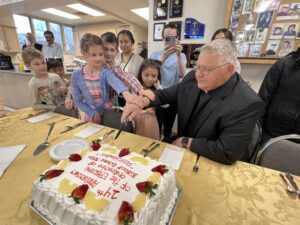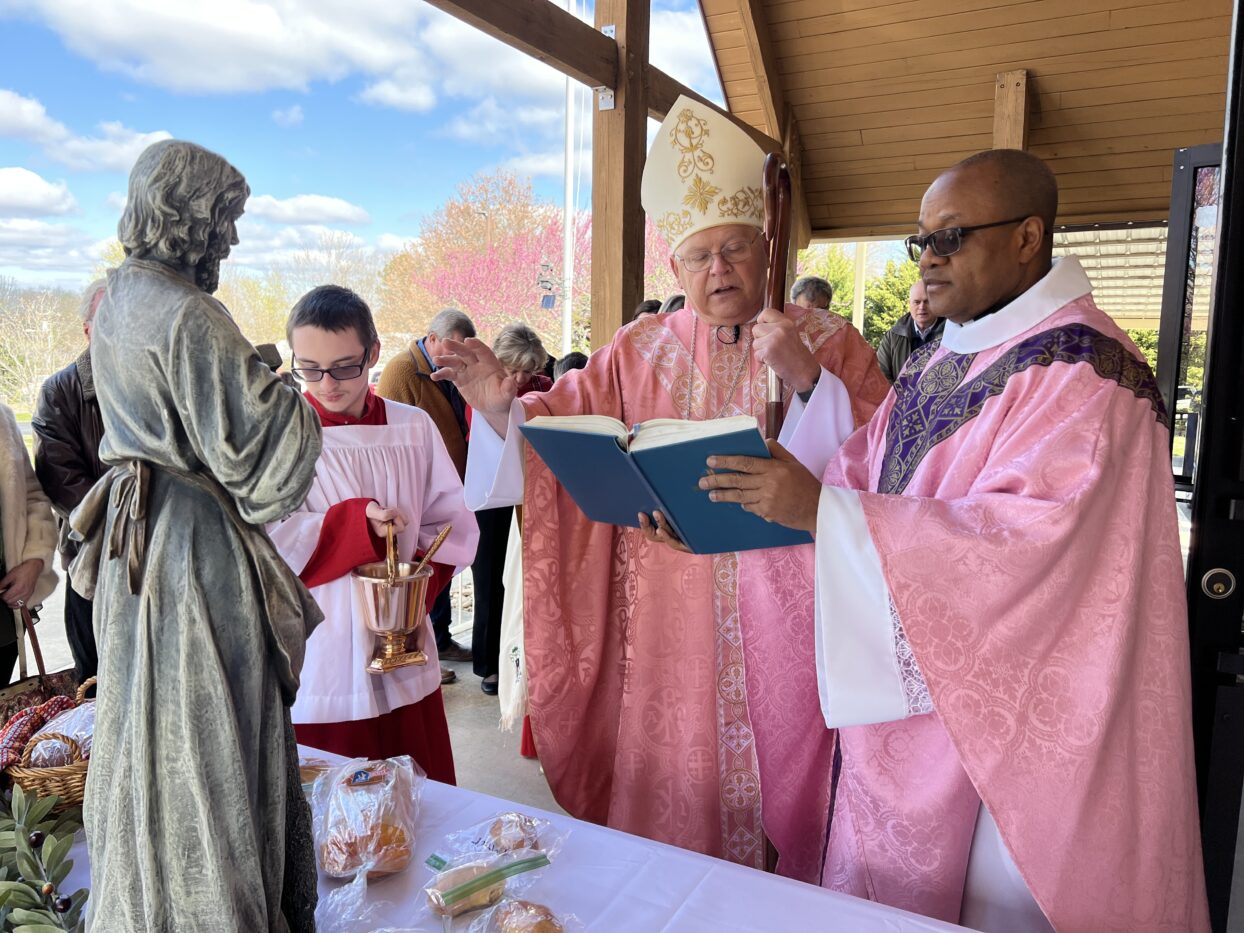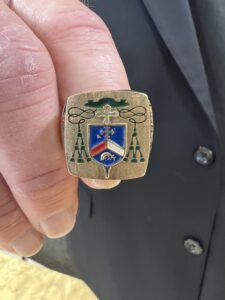Bishop Stika marks anniversary at St. Joseph the Worker with unexpected intention
By Jim Wogan
Bishop Richard F. Stika received more than gifts, gratitude, and cake on the 14th anniversary of his episcopal ordination last month. He may have received a favor in the form of a miracle.
A few minutes into a Mass celebration on March 19 at St. Joseph the Worker Church in Madisonville, Bishop Stika noticed that something felt wrong. His episcopal ring, a gift presented to him during his ordination Mass in Knoxville in 2009, was missing.
“I received the ring the day I became bishop of Knoxville. It is very dear to me,” Bishop Stika said. “It has my coat of arms and the date when I was ordained on it. I knew I was wearing it that morning, but when I did the opening prayer at Mass, I looked, and the ring was gone. It must have slipped off my hand.”
Despite the concern, Bishop Stika focused on the liturgy and continued celebrating the Mass. Still worried that he might have lost the ring during a fuel stop on the way to Madisonville or in the parking lot of the church where it might be run over, the bishop issued a plea before the final blessing at the end of Mass.
“I said to those in attendance that I have a special intention. You know how we turn to St. Anthony when we lose things? Please pray to St. Anthony for my ring. It is the ring I received 14 years ago on this day.”
Seconds later, parishioner Tina Doud, who was seated in the first row, pointed, and said, “I think it’s under your chair.”
Bishop Stika and Father Julius Abuh, pastor of St. Joseph the Worker and concelebrant of the Mass, both looked at her in disbelief.
“I think it’s under your seat,” she repeated. “Is that not it?”
Looking closer, the bishop hesitated, bent down, retrieved something, and then turned to the parishioners, smiled, and held up the ring.
“It’s a miracle,” Bishop Stika shouted. Those in attendance broke out in laughter and then applause.
“It really is a miracle,” Bishop Stika said. “I was ready to go back to the gas station and start looking through their trash cans and on the ground. Who knows where it could have fallen off? I am so grateful.”
Even Father Abuh acknowledged the power of prayer.
“That is where we see the intercession of St. Anthony,” Father Abuh said. “The bishop had just said, ‘I believe in the intercessional power of St. Anthony,’ and as soon as he said it, the parishioner said, ‘Hey, look, it is there!’ That was not a coincidence. It was providential.”
St. Anthony of Padua wasn’t the only holy soul remembered at the anniversary Mass. The Catholic Church commemorates the solemnity of St. Joseph on March 19, or this year during Lent on March 20. Bishop Stika considers St. Joseph one of his patron saints. It was a point he touched on in his homily.
“St. Joseph is never quoted in the Scriptures, but we know he existed,” Bishop Stika said. “We know he was chosen by God to teach Jesus how to be a man, to love Mary, and to protect them.”
Bishop Stika noted that the fourth Sunday of Lent, also known as Laetare (Latin: Rejoice) Sunday, and celebrated by clergy wearing rose-colored vestments, should remind the faithful that their Lenten journey is changing.
“These next weeks will remind us of the Lord’s slow passage to Jerusalem, when he enters the city triumphant and just a few days later he leaves the city to go to his tomb,” Bishop Stika said.
“Lent is not a season we should live within a confine of six weeks, because during Lent, we are reminded of things that bring us closer to the Lord: prayer, more intense prayer; the ability to give alms, to share what we have with others; and fasting, perhaps from things that we carry with us in life—to fast from things that weigh us down and cause us not to see or not to hear.
“I think the lesson from Scripture today is the ability to listen and the ability to hear. We hear all kinds of things, and we don’t really pay much attention. Do we listen to the invitation of God to come and to follow, to believe and to trust, and to seek understanding that comes from God himself?” Bishop Stika asked.

Young parishioners at St. Joseph the Worker Church help Bishop Stika cut the cake commemorating his 14th anniversary as a bishop.
Fourteen years ago, on March 19, 2009, Bishop Stika was ordained the third bishop of the Diocese of Knoxville in a fashion befitting any episcopal ordination rite—a Catholic Mass attended by an estimated 5,000 worshipers, clergy, religious, well-wishers, Catholic leaders, and civic dignitaries that took place inside a massive and reverently furnished assembly hall at the Knoxville Convention Center.
It was a liturgy so huge and significant that it was televised on four large videoscreens inside and was live streamed to a global Internet audience outside. It marked the beginning of a new era for the Diocese of Knoxville, one that has seen unprecedented growth and remarkable stability.
Perhaps, someday, there will be a time to replicate what took place in 2009—a celebration of similar stature for the 15th, 20th, or even the 25th jubilee of that occasion. But Bishop Stika chose a more humble setting to celebrate the 14th anniversary of his elevation to bishop life—a small, vibrant parish located in a rural area about 50 miles south of Knoxville, a parish that in many respects reflects the Diocese of Knoxville as much, if not more, than its bigger parishes.
“For us, it is a great honor. For me, I consider it a privilege to have a successor of the Apostles, the bishop of the Diocese of Knoxville, to be in our parish on this day,” Father Abuh said. “Not only to celebrate the anniversary of his episcopal ordination, but also to celebrate with us the feast of St. Joseph, spouse of the Blessed Virgin Mary.”
Father Abuh noted preparations his parish made to celebrate the anniversary with Bishop Stika. After Mass, and the blessing of bread at a St. Joseph’s table outside, more than 100 people gathered in the church basement for a reception that included food and a special blessing for Bishop Stika that was sung by parishioners.
“Bishop Stika requested to come here to celebrate his anniversary Mass,” Father Abuh said. “He asked if it was OK for him to join us for this celebration, and I said ‘absolutely.’ It would be a great joy and a great privilege to have him celebrate Mass with us.
“As you can see, everyone is so excited to have him here. The Hispanic community made two big cakes, not just one, two big cakes, because everyone has been looking forward to this day. Bishop Stika’s presence for us is like the presence of Christ visible.”
The visit to Madisonville offered Bishop Stika an opportunity to thank the religious order of Glenmary priests who were instrumental in establishing the parish in 1992, and to remember former pastor Father P.J. McGinnity, who served at St. Joseph the Worker for seven years before relocating to Ireland.
“Last year, I spent three days in Ireland with Father P.J.,” Bishop Stika told St. Joseph the Worker parishioners. “Now, he helps at parishes in a beautiful little village where he lives. I am sure he wants me to tell you how much he loves you all.”
The Madisonville visit also came during the height of confirmation season. From March until June, Bishop Stika will drive more than 4,200 miles (the equivalent of driving from Knoxville to Los Angeles to San Francisco to Chicago) and visit 34 parishes. It’s a daunting task for the bishop of a large diocese covering 36 mostly rural and mountainous counties.
“Last week I was at St. Ann Parish in Lancing (100-mile round trip),” Bishop Stika said. “They had 20 families at Mass. As I travel around the diocese and visit different parishes, I say the same thing at the end of Mass. It’s simple. I say, thank you. I feel at home here, despite some challenges. I just do God’s work by paying attention and focusing on building a diocese that is doing so well.”


